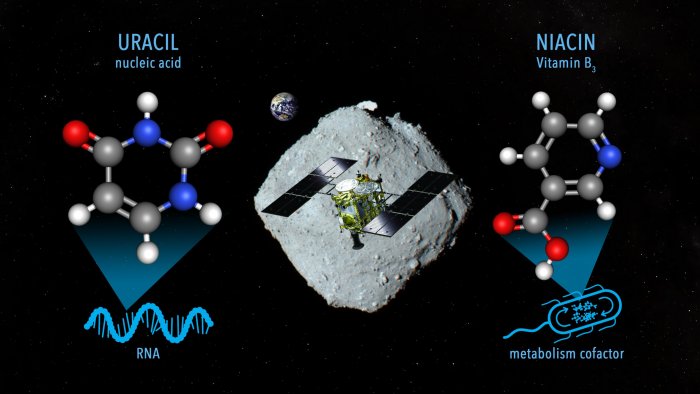Eddie Gonzales Jr. – MessageToEagle.com – Researchers have analyzed samples of the asteroid Ryugu collected by the Japanese Space Agency’s Hayabusa2 spacecraft and found uracil, one of the informational units that make up RNA, the molecules that contain the instructions for how to build and operate living organisms.
A conceptual image for sampling materials on the asteroid Ryugu containing uracil and niacin by the Hayabusa2 spacecraft (NASA Goddard/JAXA/Dan Gallagher). Credit: NASA Goddard/JAXA/Dan Gallagher
Nicotinic acid, also known as Vitamin B3 or niacin, which is an important cofactor for metabolism in living organisms, was also detected in the same samples.
This discovery by an international team, led by Associate Professor Yasuhiro Oba at Hokkaido University, adds to the evidence that important building blocks for life are created in space and could have been delivered to Earth by meteorites. The findings were published in the journal Nature Communications.
“Scientists have previously found nucleobases and vitamins in certain carbon-rich meteorites, but there was always the question of contamination by exposure to the Earth’s environment,” Oba explained. “Since the Hayabusa2 spacecraft collected two samples directly from asteroid Ryugu and delivered them to Earth in sealed capsules, contamination can be ruled out.”
The researchers extracted these molecules by soaking the Ryugu particles in hot water, followed by analyses using liquid chromatography coupled with high-resolution mass spectrometry. This revealed the presence of uracil and nicotinic acid, as well as other nitrogen-containing organic compounds.
“We found uracil in the samples in small amounts, in the range of 6–32 parts per billion (ppb), while vitamin B3 was more abundant, in the range of 49–99 ppb,” Oba elaborated. “Other biological molecules were found in the sample as well, including a selection of amino acids, amines and carboxylic acids, which are found in proteins and metabolism, respectively.” The compounds detected are similar but not identical to those previously discovered in carbon-rich meteorites.
The team hypothesizes that the difference in concentrations in the two samples, collected from different locations on Ryugu, is likely due to the exposure to the extreme environments of space. They also hypothesized that the nitrogen-containing compounds were, at least in part, formed from the simpler molecules such as ammonia, formaldehyde and hydrogen cyanide. While these were not detected in the Ryugu samples, they are known to be present in cometary ice—and Ryugu could have originated as a comet or another parent body that had been present in low temperature environments.
“The discovery of uracil in the samples from Ryugu lends strength to current theories regarding the source of nucleobases in the early Earth,” Oba concludes. “The OSIRIS-REx mission by NASA will be returning samples from asteroid Bennu this year, and a comparative study of the composition of these asteroids will provide further data to build on these theories.”
Written by Eddie Gonzales Jr. – MessageToEagle.com Staff







